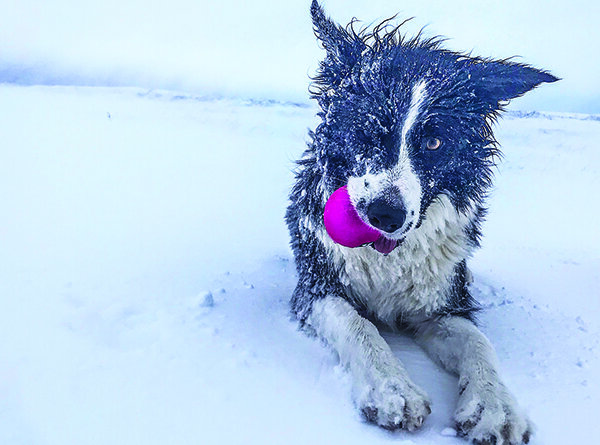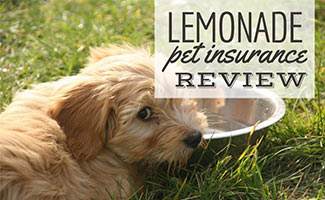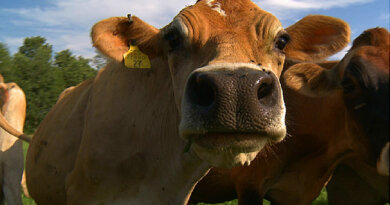Maintaining and Protecting Your Dog’s Paws During Winter
The sky was a brilliant blue, with glimmers of sparkling snow flashing across the path ahead as a light breeze blew it into the air, adding a pinch of magic to the scene. The temp hovered around a lovely 25°F (-3°C), and the only sound heard for miles was the swish of my skis combined with the heavy breathing of happy dogs with tongues lolling. We were running out of light, so I peeled off our scheduled route and zipped up a hill, a quicker, albeit steeper, way home.
As we climbed, I noticed my Border Collie pause briefly and look at his feet, but he kept going. I made a mental note to check his paws when we got home. We turned the corner, began our descent, and joyfully charged downhill.
Then, he stopped – suddenly – and started frantically biting at his feet. I kicked my way out of my ski bindings so I could reach him and help him with what I (correctly) guessed was bedeviling him: Snow had stuck to the hair between his paw pads, and icy balls had formed and expanded between his pads, causing his toes to splay uncomfortably. I felt terrible. In my enthusiasm to get out into this beautiful day, I failed to check the length of the fur on his feet before we left and he paid the price for my oversight.
Had I attended to this winter dog husbandry chore before we hit the trail, our outing would have been near perfect; the snowy, cold, but clear conditions were perfect for my athletic canine sidekick, who is well habituated to our chilly Montana winters.
THE BASICS OF WINTER PAW MAINTENANCE

But snow, ice, and cold aren’t the only foes our canine companions’ paws have to contend with in winter. In other parts of the world, there are other hazards that wreak havoc on the four-footed – including salt and other de-icing agents and persistently wet and/or muddy conditions – and a little regular maintenance goes a long way to keeping our friends up and running. Literally.
* Nail trimming. While many dog owners long to believe that time running on hard surfaces is sufficient to wear canine nails to an appropriate length, it’s just not so. No matter where you live, no matter what weather or surfaces your dogs are exposed to, regular nail trimming is vital to healthy paws.
John Wright, a trainer of champion Springer Spaniels in Bozeman, Montana, logs serious miles daily year-round with his dogs and knows all too well the importance of nail trimming. “Long, neglected nails are more likely to break or split in winter conditions with frozen ground or hard, slippery ice. A broken nail is a lame dog for a week or two,” he explains.
“Clip those nails! It’s quick and easy once you get the hang of it, it’s a 90-second gig for four paws,” Wright adds. Easy for someone with a lot of experience, perhaps less so for others. Nail trimming can be an anxious endeavor, which raises the anxiety for our canine companion receiving that care. Have you ever had your hair cut by someone who was unsure of what they were doing – or who actually nicked your ear with her scissors? That’s a chair everybody’s quick to jump out of!
An article in WDJ’s October issue (“Rotary Club”) discussed nail trimming techniques and tools. It may be additionally helpful to get an in-person tutorial on nail trimming from your favorite groomer or vet tech or whomever has the skills that instill ease and confidence in your dog. If you are like me, once you have the know-how you’ll wonder what you were so worried over in the first place!
I turn nail trimming into bonding time. At least once a month, my dogs get a relaxing turn at the (home) spa, complete with a pedi-pedi and a paw pad massage (more on this below).
* Hair trimming between pads and toes. As my experience on that otherwise perfect day illustrates, medium and long-haired dogs need to have the hair between their paw pads and toes kept short. This prevents the formation of snow and ice balls that can cause painful bruising and injury to tendons.
I prefer to do this myself, rather than go to a groomer, because it’s a quick and easy job with the right clippers. The best clippers for paws (around faces and ears too) are small, quiet, and cordless.
Many years and several pairs of clippers later, I discovered Cyrico cordless professional pet clippers and swear by them. Forget about trying to find an outlet in a spot where hair can conveniently fly; cordless trimmers allow you and your dog to be wherever you are most comfortable. And they hold their charge surprisingly well! (Here is a link to my favorites: tinyurl.com/WDJ-cordless-clippers.)
Whatever clippers you choose, it’s helpful if they are relatively quiet, helping to reduce noise and vibration, which can trigger anxiety in some dogs. Of course, even the quietest clippers still make noise, so I found it helpful to teach my dogs to associate a tasty treat (they highly recommend bacon-flavored Cheez Whiz) with the sound of clippers before they even touch the dog’s fur. It’s a tiny bit of effort that allows for a lifetime of calm clipping.
If the snow doesn’t fly where you live, but the rain is frequent, keeping the hair trimmed on your dog’s paws will reduce mud and crud that can accumulate between the dog’s toes (and track onto your floors), and it helps paws to dry properly. Excess water can create bacterial buildup between the toes, leading to itchiness, sores, and infections.
* Protect with paw balm. Salt and chemical deicers on sidewalks are great for reducing slips, but can cause paws to become irritated, and some can be dangerous if ingested. Applying a balm to paws prior to heading outdoors provides a nice buffer between the paw pads and the treated walkways.
The reigning standard balm for paw protection in winter (and summer!) is Musher’s Secret. It’s made from a blend of food-grade, organic waxes that form a semi-permeable shield on the pads, allowing perspiration to escape through the toes. It’s also non-toxic and non-allergenic.
While I find it to be a very useful product, its maker claims that Musher’s Secret will prevent balls of ice and snow from forming on a dog’s paws and in between their toes. In test after test on a variety of dogs, all medium and long-haired, Musher’s Secret has never prevented paw-snowballs for my dogs. Ever. This is not a deal-breaker, just a bit of an over-sell.
You will still have to keep paw hair trimmed. (If this just prompted groans, I assure you trimming is not that bad. In a winter season in Montana that lasts six months or more, I trim paw-fur three or four times and it takes five minutes or less per dog. It’s really not that bad!)
Here’s another winter hazard for our dogs’ paws: those huge swings in temperature and humidity as you travel indoors and out. These are absolutely fabulous conditions for drying out and cracking paw pads – your hands likely suffer the same fate in winter! I personally want one balm to rule them all, protecting and treating dog paws and mine too, so I make my own (see my recipe on page 15). I add essential oils to enhance the spa experience!

* Boots. There comes a time when winter conditions will make boots your best friend’s best friends.
Dogs have varying sensitivity to cold, but by -10°F (-23°C), you start to see all dogs holding up paws, sometimes trying to simultaneously lift three or four paws off the cold surface – it’s quite a sight to behold!
Older dogs, especially, don’t thermoregulate as well and their feet become increasingly sensitive to cold. Boots can make a huge difference for them, allowing them to comfortably get out and enjoy winter. Dogs with short or thin coats need extra protection, too.
However, if your dog has never worn boots and you suddenly toss them on, prepare for a high-stepping protest march complete with bucking and kicking. Boots take some getting used to.
You’ll have to spend some time introducing them to your dog. Putting them on and then doing something fun right away distracts them from this new, very awkward accessory. Several short sessions will start to ease a dog toward boot-happiness.
A good fit is critical for your dog’s comfort, although it can be challenging to find just the right size; every manufacturer’s sizing varies slightly. When in doubt, order products in the two closest sizes and try them on indoors at home. Don’t try to “make do” with a close fit; you’ll just end up hurting your dog and souring him to future attempts with better-fitting boots.
How should you identify good boot candidates? Look for:
• Durability. Look for quality material without excessive bulk.
• Flexibility and comfort. Dog boots need to be supple and flexible, especially at the dogs’ wrists and ankles. Dismiss the ones that are stiff throughout, rising high on the leg, with a lot of straps to keep the boot in place, which can hinder movement and do more damage to a foot than the elements!
• Good workmanship. Seams, zippers, and patches of hook-and-loop material (such as Velcro) should be minimal, and nothing should feel rough on the inside of the boot. Anything that protrudes on the inside of the boot can cause sores on the dog’s foot or leg.
• Visibility. The brighter the boots, the more likely you will find them after your dog manages to lose one or more.
I’ve tried many models from a number of companies, but I find myself going back to the same two companies again and again.
Ruffwear (ruffwear.com) is great about helping dog owners find the right boot and fit for their dogs’ needs. Most of their boots are a bit technical; figuring out how to get them on and worn comfortably can take some work, but they’re worth it.
Hurtta (hurtta.com) also makes great boots. Their products are easier to put on the dogs and tend to be comfortable straight out of the box with minimal fuss.
Once your dog is accustomed to his boots, don’t tune out; you need to stay alert to any sign of discomfort. If a boot slips or twists, it won’t take long for an errant seam to rub a paw raw. Check the fit periodically when you’re out to prevent these sorts of unfortunate boot-mishaps. Few things can ruin an outing faster than a boot rubbing the wrong way.
Homemade Paw Balm
Yields six 1-oz jars
You’ll need:
• Small pot and glass bowl or double broiler
• 2 oz olive oil
• 2 oz coconut oil
• 1 oz shea butter
• 4 tsp beeswax
• Optional scent: Use only therapeutic-quality essential oils to meet your personal scent preference. My favorite combination is 3 drops each of lavender, mandarin, and chamomile essential oils.
• Also optional: 1⁄4 tsp vitamin E oil as a preservative
1. Pour an inch or two of water into the bottom of a double boiler, or set a glass measuring cup into a pot of water so that the glass bottom is submerged and the top is exposed. Bring the water to a simmer.
2. Add coconut oil, olive oil, and shea butter to the glass cup or the top of the double boiler.
3. As the mixture warms and melts together, add the beeswax. When the beeswax begins to float to the top, stir the mixture continuously.
5. Set out six 1-oz jars and add the essential oils (and optional vitamin E for increased shelf life) to each jar.
6. Pour the melted base into the jars. Stir lightly (a chopstick works well for this) to mix the essential oil and vitamin E into the base.
7. Cover with breathable material (e.g., cheese cloth) and cool until they harden.
Enjoy for one long, cold winter (longer if you add the vitamin E).
Kathryn Socie-Dunning lives in Montana with her husband, toddler son, and two snow-loving dogs.






